| Disparate authors such as Celsus, Vitruvius,
Pliny, Frontinus, Columella, Varro and Vegetius, show the Roman concept of
health interwoven with the normal life and ordinary process of government
in the Roman Empire. Vitruvius, a practicing architect in the milieu of
the Roman Empire, shows through his writing how important sanitary
planning was for public buildings. His chapter on city planning begins
with a discussion of the salubrity of sites and throughout this section
the influence of the Hippocratic tract Airs, Waters, Places is
apparent:
“In the case of the walls these will be the main points: First, the
choice of the most healthy site. Now this will be high and free from
clouds and frost, with an aspect neither hot nor cold but temperate. In
this way a marshy neighborhood will be avoided. For when the morning
breezes blow towards the town at sunrise, as they bring with them mists
from the marshes and, mingled with the mist, the poisonous breath of the
creatures of the marshes [i.e., microorganisms], to be wafted into the
bodies of the inhabitants, they will make the site unhealthy.” (De
Architectura I.2-5) |
Forum Baths, Pompeii, first century BCE Caldarium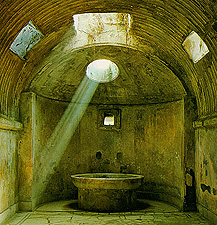
One of the characteristic Imperial Roman building types is the giant
bath complex which could house not only bathing facilities but lecture
halls, gymnasia, libraries and gardens. Roman bathing establishments
usually provided three kinds of baths, i.e., hot, tepid and cold. The room
pictured above was kept warm by hot air circulating through pipes in the
walls and floor. |


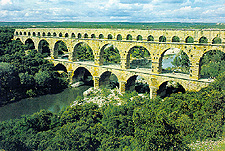
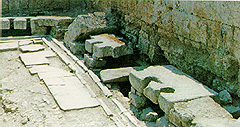
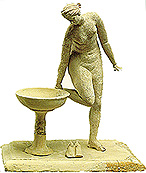
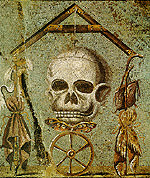 The skull is
symbolic of man’s fate and reminds us of the frailty of human existence. Rather
than shrink from signs of death, the Romans seem to have employed them as
reminders to “seize the day”. This particular mosaic was used as a tabletop.
There are many extant examples of cups and dining areas adorned with skeletal
motifs. In Petronius’ Satyricon, in the middle of a great banquet, a slave
brings in a silver skeleton put together with flexible joints, and after it was
flung on the table several times, the host Trimalchio recited: Man’s life,
alas, is but a span So let us live it while we can, We’ll be like this when
dead. Despite the advanced state of sanitation engineering in the Roman
world, the average life span was only 30-40 years.
The skull is
symbolic of man’s fate and reminds us of the frailty of human existence. Rather
than shrink from signs of death, the Romans seem to have employed them as
reminders to “seize the day”. This particular mosaic was used as a tabletop.
There are many extant examples of cups and dining areas adorned with skeletal
motifs. In Petronius’ Satyricon, in the middle of a great banquet, a slave
brings in a silver skeleton put together with flexible joints, and after it was
flung on the table several times, the host Trimalchio recited: Man’s life,
alas, is but a span So let us live it while we can, We’ll be like this when
dead. Despite the advanced state of sanitation engineering in the Roman
world, the average life span was only 30-40 years.
